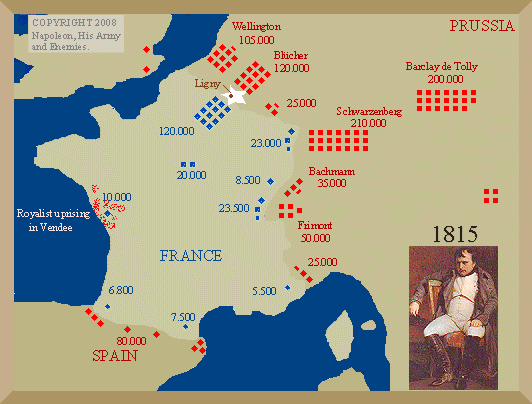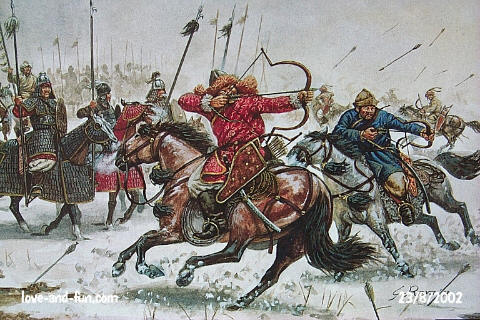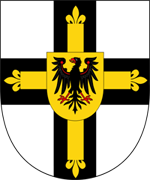Part 1 is about how to use numerical superiority.
To begin with, wargaming is not real war. It is a simplification, which represents real things like firepower or freshness of the troops through numbers. War is the duel of two 'individuals' on a grand scale, according to Clausewitz. When two armies of soldiers fight in wargaming, every individual troop has a certain amount of 'health' or 'hit' points and 'damage' points. When a soldier fights another soldier, both periodically inflict damage to each other depending on their 'damage' points. This is subtracted from each soldier's hit points (abbreviated HP) and they inflict damage until one is dead. In real life it's more complicated and wargames usually have things like magic or morale to spice things up. In the artificial environment of wargames, however, the most basic way of looking at a fight is two troops draining each other's HP as fast as their DPS (damage per second) allows them. These simplifications are the set of axioms on which the manual is built.
For that reason two armies fighting is similar to two soldiers hitting each other. Each reduces the enemy's hit points periodically until one is dead. Only the group sizes vary. These are two space marines (from StarCraft). Each has 40 hit points and deals 5 points of damage per second. In the most basic conditions, they will both destroy each other in 8 seconds.
And so, firstly and most basically, hitting first, before the enemy, gives an advantage.
1 More important is
numerical superiority. Numerical superiority works by allowing us to drain the enemy hp faster than he drains ours. Consider a fight between warships in the sea. Each has 10 hp and deals 1 dps. We have 30 and the enemy (abbr. ENY) has 25. Initially, we will be hitting with 30 dps and they will be hitting us with 25 dps. As the following wrong table describes,
We will win
We win but it's actually wrong. This table assumed that all troops live to the very end, taking equal damage. This means that the enemy has retained his full firepower of 25 dps for the whole fight. BUT, in reality both we and the enemy will have our different ships take damage randomly, some dying before the others. This means that we will lose some of our dps capability and by the end of the combat we will drain enemy hit points SLOWER than we did when we started. Consider the same fight. Only now each time the ships hit each other they mangle the hulls, disable cannons and wreak havoc among the crew. This reduces the fire capability. Also, some of our ships take critical damage and sink, while others are lucky and stay afloat while their comrades blow up beside them. RTS's universally have this chaotic damaging and this means that the whole dps of the army is reduced throughout the fight.
What people may not realize is that if the enemy is less numerous, his dps is reduced faster than ours. Because the enemy troops will more frequently die before ours die, the enemy will lose his firepower faster than we do. The situation will look somewhat like this
The formula is available dps minus the dps lost after each enemy bombardment (due to our ships being shot at, hulls destroyed, cannons disabled, etc.). The calculations are at the end. As you can see, we wipe out the enemy's firepower faster, and although we lose some dps in the fighting, the enemy loses it even faster. Which, by the way, is exponential decay.
The yellow area is our advantage without considering the enemy's loss of firepower due to our bombardment. The green area is our advantage when this is taken into account. These calculation clearly show how numerical superiority works in a simple RTS environment of identical units (that has no morale, etc.). If it's getting narrow it's a bad sign – we are out-gunned and may lose.
When things become more complicated, with varying units and movements, the lines will vary greatly, but Part 2 explains this.
2 Focusing fire
Focusing fire is ordering nearby troops to simultaneously fire at enemies one by one.
In most RTS's units deal their full damage regardless of whether they are at full health, 50% or just 1 hp. So, as long as our units are alive, we will keep our dps and damage all over our troops is not much of a worry.
Two armies have both a hundred troops, totaling 1000hp and 200 dps. Ours focuses fire and the other hits at random.
After the first exchange of thoughts, our troops will have only 80% hp left but will be still alive, amounting to 800hp and 200 dps. The enemy will have lost 20 men, leaving him with 800 hp in 80 unscathed men who only maintain 160 dps.
After the next salvo, we will have 640hp and ~180-190 dps left (some troops are less lucky than others) but the enemy will have 600hp, 60 men and only 120 dps.
Thus, focusing fire is the way to reduce the enemy dps as fast as possible.
Depending on the game mechanics or, in real life, on the technology, hitting as many enemies as possible may be a better option. But it's all about the mechanics. The chief factor is how much firing capability is lost from enemy fires. Clausewitz points out the effect of fires during the Napoleonic wars:
'1000 men fire twice as many shots as 500, but more shots will take effect on the 1000 than on the 500 because it is assumed that they stand in closer order than the other. If we were to suppose the number of hits to be double, then the losses on each side would be equal. From the 500 there would be for example 200 disabled, and out of the body of 1000 likewise the same; now if the 500 had kept another body of equal number quite out of fire, then both sides would have 800 effective men; but of these, on the one side there would be 500 men quite fresh, fully supplied with ammunition, and in their full vigour; on the other side only 800 all alike shaken in their order, in want of sufficient ammunition and weakened in physical force.' (http://www.gutenberg.org/files/1946/1946-h/1946-h.htm#2HCH0022)
In most games, soldiers are not programmed to get tired or shocked from being fired upon, so this is nothing to worry about, as long as they are alive and capable of dealing damage.
3 Achieving numerical superiority through maneuver
Maneuvering is the movement of troops during the battle. If we plan the movements of our units well we can mass superior firepower at some enemy units while avoiding encounter with others. It is like focusing fire on a bigger scale, so that our battalions kill more enemy battalions than he kills. For example, here comes the enemy, at random, in urban terrain.
Here, both sides are of equal strength. The Red enemy will march in our general direction, without regard for a whole lot, by 3 nearby paths. We will send our troops in the two planned areas, where we will have numerical superiority.
The enemy expects us to also march more or less in his way, so he finds his middle group alone, while we are fighting the rest of his army with our full force.
Now his central group, which we kept away from before, is outnumbered by our force and will be destroyed.
I haven't seen this done a lot, probably because it requires too much planning and 'S=vt' calculations and it's easier to just keep the army in one place.
4 The out-calculation nature of wargaming
In this example, nothing prevents the enemy from doing the same. In fact, he may choose to split his force into more than 3 groups and move around in various ways, out-maneuvering us. If he tries to, we should then predict where he may be going – all likely directions – and calculate the direction of our troops in response. In reality, neither person knows all the calculations of the enemy. People attack as soon as it seems advantageous, not knowing how much has the enemy foreseen. As a result, whoever has pre-planned the most movements wins. In its very basic form, wargaming is about out-calculating the enemy.
I imagine real war is a lot like this, too. Napoleon, at least, would plan campaigns and movements in great detail, making himself prepared for anything and assuring his battalions, when on the battlefield, will be supported by other battalions and so on. It worked well enough.
5 Achieving numerical superiority through surprise
When a player moves his army around the map and sees an enemy army coming his way, he moves away if the army is stronger. He attacks if the army is weaker and the odds are favorable. Some games have ways to make troops invisible (WarCraft3, BFME2, etc.) and we can thus hide half our army. If we then parade the visible half in front of other players, they will usually pursue and can be led to the hidden troops. There, the enemy suddenly faces superior numbers and we have a sudden advantage in numbers. People seldom use this, even if the game allows it, but it deserves a mention.
6 Strategy of the central position
Strategy of the central position is a method used by Napoleon that allowed him to defeat even numerically superior enemies. Applicable when the enemy is split in parts that we can defeat, it consists of sending small units to delay enemy groups while we deal with one. If the enemy was coming in two columns of 10 000 each, Napoleon would slow down one with a detachment of 3-4000 and engage the other with 16-17000. The first column was delayed by the French and so Napoleon would destroy the second one before marching to help his heavily outnumbered detachment. Thus, he maintained an economy of force (Dupuy 1984:163). Napoleon used something similar on a large scale during his last 100 days. When France was about to be invaded from all sides and Napoleon simply didn't have enough armies to win everywhere, he dispatched smaller units to Spain and on the Eastern border while the main big army set to Brussels to defeat Wellington first, followed by the Prussians further away and so on.

http://napolun.com/mirror/napoleonistyka.atspace.com/img/map_France_1815.gif
A variation of this was used by the Wehrmacht by the end of WW2. When the Red Army was approaching Warsaw, the Polish resistance rose against the Germans in August 1944. The Poles were driven back and eventually divided in several separate areas in the city centre. The divided Polish groups were all pinned down and the Germans overrode them one by one during September. Like Napoleon, the Germans maintained an economy of force by only trying to overrun (and succeeding) the Poles one island at a time. Similarly, we want to try to divide the enemy force in manageable groups, as much as the game mechanics allow it, and overpower each group one by one.
http://www.warsawuprising.com/images/map3b.jpg
CALCULATIONS
Time Friendly dps ENY dps
1 30 – 2.5* = 27.5 25 – 3 = 22
2 27.5 – 2.2 = 25.3 22 – 2.8 = 19.2
3 25.3 – 1.9 = 23.4 19.2 – 2.5 = 16.7
4 23.4 – 1.7 = 21.7 16.7 – 2.3 = 14.4
5 21.7 – 1.4 = 20.3 14.4 – 2.2 = 12.2
6 20.3 – 1.2 = 19.1 12.2 – 2 = 10.2
7 19.1 – 1 = 18.1 10.2 – 1.9 = 9.3
8 18.1 – 0.9 = 17.2 9.3 – 1.8 = 7.5
9 17.2 – 0.8 = 16.4 7.5 – 1.7 = 5.8
10 16.4 – 0.6 = 15.8 5.8 – 1.6 = 4.2
11 15.8 – 0.4 = 15.4 4.2 – 1.6 = 2.6
12 15.4 – 0.3 = 15.1 2.6 – 1.5 = 1.1
13 15.1 – 0.1 = 15 1.1 – 1.5 = -0.4
* this number is the average amount of dps we lose after our fleet is shot by the enemy. 25 enemy dps is applied to our ships. Each ship has 10 hp, so when our fleet takes 25 points of damage, we lose an average of 2.5 ships for the purpose of simplification.





























